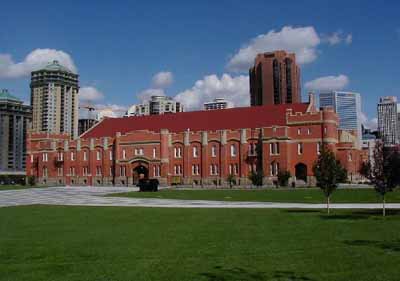Mewata Drill Hall / Calgary Drill Hall National Historic Site of Canada
Calgary, Alberta

Environment and setting
© Parks Canada/Parcs Canada, 2004
Address :
801 11th St. SW, Calgary, Alberta
Recognition Statute:
Historic Sites and Monuments Act (R.S.C., 1985, c. H-4)
Designation Date:
1989-06-22
Dates:
-
1917 to 1918
(Construction)
Event, Person, Organization:
-
South African War
(Event)
-
World War I
(Event)
-
Calgary Highlanders
(Organization)
-
King's Own Calgary Regiment
(Organization)
-
T.W. Fuller
(Architect)
-
Leo Dowler
(Architect)
Other Name(s):
-
Mewata Drill Hall / Calgary Drill Hall
(Designation Name)
Research Report Number:
DRILL HALLS - 1989
DFRP Number:
15202 00
Plaque(s)
Existing plaque: 801 11th St. SW, Calgary, Alberta
The scale and bold design of the Mewata Armoury exemplify the wave of national pride that greeted Canada's strong performance in the South African War. In western Canada this military enthusiasm led to a dramatic increase in militia enrolment and resulted in the construction of new drill halls and armouries on an unprecedented scale. Mewata Armoury, one of the largest and most fully equipped of its type, was built in 1917-1918. For many years it has been home to the King's Own Calgary Regiment and the Calgary Highlanders, both of which were established in 1910.
Description of Historic Place
Mewata Drill Hall / Calgary Drill Hall National Historic Site of Canada is a large, Tudor Revival style drill hall, located in Calgary, Alberta. The size of the structure, its very complete facilities, and prominent location all speak to the pride in which Canada's emerging military was held at the time of its construction, and to the central role the military was to play in Canadian history in the 20th century. The official recognition refers to the exterior and interior of the building on its property at the time of its designation in 1989.
Heritage Value
Mewata Drill Hall / Calgary Drill Hall was designated a national historic site of Canada in 1989 because: it is a good representative example from the third phase of drill hall construction in Canada (1896-1918); the scale and bold design of the Mewata Armoury exemplify the wave of national pride that greeted Canada's strong performance in the South African War and which led to a dramatic increase in militia enrolment in western Canada; for many years it has been home to the King's Own Calgary Regiment and the Calgary Highlanders, both of which were established in 1910.
The Mewata Drill Hall / Calgary Drill Hall features elements of the third phase of drill halls constructed in Canada, characterized by a departure from the picturesque Romanesque Revival of earlier drill halls, to a more monumental late mediaeval Tudor Revival style. The reduction in superfluous ornamentation and the simplicity of composition reflect a desire to impose discipline on architectural design, typical of the third phase of drill hall construction in Canada.
The scale and bold design of the Mewata Drill Hall / Calgary Drill Hall exemplify the wave of national pride that greeted Canada's strong performance in the South African War. In western Canada, this military enthusiasm led to a dramatic increase in militia enrolment and resulted in the construction of new drill halls and armouries on an unprecedented scale. The Mewata Drill Hall / Calgary Drill Hall, one of the largest and most fully equipped of its type, was built in 1917-1918. For many years it has been home to the King's Own Calgary Regiment and the Calgary Highlanders, both of which were established in 1910.
Source: Historic Sites and Monuments Board of Canada, Minutes, June 1989.
Character-Defining Elements
Aspects of this site which contribute to its heritage value include: those elements which speak to the third phase of drill hall construction, namely the rational, Beaux-Arts-style interior layout with a large, central drill space surrounded by areas for ancillary functions including weapons storage and practice, physical training and educational programmes, and washrooms; those elements which speak to the scale and bold design of the drill hall, specifically the Tudor-revival architectural style evoking medieval fortifications, represented by four large, square, bastion-like corner towers linked by continuous crenelated exterior walls and decorative touches including stylized bartizans, narrow windows and firing slits, red brick surfacing enlivened by decorative stone work, string courses, lintels, voussoirs, and a towered central Tudor-arched entry recalling fortress gates; surviving original Tudor-Revival-style interior decor, including the fireplaces, wood wall panelling and faux beams of the officers' mess; those elements which speak of the pride attached to Canada's military performance overseas, namely the prominent location and high profile accorded this building in its urban landscape.